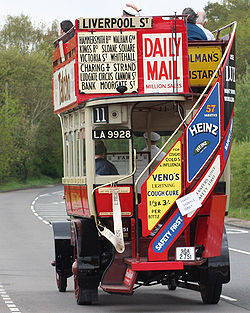- LGOC B-type
-
LGOC B-type 
B340, owned by the London Transport Museum; London to Brighton Run, 2006Manufacturer London General Omnibus Company Built at Walthamstow, London Specifications Floor type Step entrance Doors 1 door Options Various customer options The LGOC B-type is a model of double-decker bus that was introduced in London on 1910. It was both built and operated by the London General Omnibus Company (LGOC).
Contents
History
B-type buses were built in Walthamstow and replaced the X-type bus. B-type buses were an improvement on the X-type. The B-type had a 34 seat capacity and is often considered to be the first mass produced bus. The first bus began carrying passengers in 1911[1]. By 1913 around 2500 had entered service.
The B-type was designed by Frank Searle, who was chief engineer of the LGOC. It had a wooden frame, steel wheels, a worm drive and chain gearbox. Its top speed was 16 miles an hour, which was above the legal speed limit at that time of 12 miles an hour however some B-types could reach 30–35 miles an hour under the right conditions.[2]
B-types carried 16 passengers inside and had seats for 18 on the uncovered top deck. These outside seats were fitted with wet-weather canvas covers. Electric lighting was introduced from 1912, and headlights in 1913. Before this, it was thought that interior lighting would render the bus sufficiently visible at night.[2]
World War I service
A total of 900 of the buses were used to move troops behind the lines during World War I[1]. After initially serving without any modifications they were painted khaki, had their windows removed, and were fitted with 2 inch thick planks to provide some limited protection.[1] Some had anti-aircraft guns attached to them, others were made into pigeon lofts to house the pigeons used for communication along the front.[2] They served until the end of the war when they were used to bring troops home[1]. The Imperial War Museum preserves one of these buses, B43, known as Ole Bill after the contemporary cartoon character.[3]
Gallery
Notes
- ^ a b c d Livesey, Jack (2007). Armoured Fighting Vehicles of Would Wars I and II. Southwater. p. 84. ISBN 9781844763702.
- ^ a b c "Exploring 20th Century London - Buses". Museum of London. http://www.museumoflondon.org.uk/English/Collections/OnlineResources/X20L/Themes/1/1095/. Retrieved 2008-05-30.
- ^ "Ole Bill Bus". Imperial War Museum. http://www.iwm.org.uk/server/show/nav.3213/outputRegister/html. Retrieved 4 December 2010.
References
- Thackray, Brian (2001). The AEC Story:Part 1. Venture Publications Ltd. ISBN 1-898432-37-6
- Thackray, Brian (2004). AEC Vehicles: Origins to 1929. Venture Publications Ltd. ISBN 1-898432-44-9
- Townsin, A. A. (1980). Blue Triangle. Transport Publishing Company. ISBN 0-903839-34-2
Buses 400-series · 500-series · B-type · Bridgemaster · K-type · LS-type · Merlin/Swift · Monocoach · NS-type · Q-type · Ranger (between wars) · Ranger (post war) · Regal · Regal I · Regal II · Regal III · Regal IV · Regal V · Regal VI · Regent · Regent II · Regent III · Regent III RT-type · Regent IV · Regent V · Reliance (660) · Reliance · Reliant · Renown (1920s two-axle) · Renown (3-axle) · Renown (1960s) · Routemaster/Routemaster FRM · S-type · Sabre · T-type · X-typeTrolleybuses 601 · 602 · 603/603T · 604 · 605 · 607 · 661T · 662T · 663T · 664TTrucks 4G6 · 10 · 18 · 201 · 428 · 501 · 506 · 691 · 692 · 701 · 1100 · Majestic · Mammoth · Mammoth Major · Mandator · Marshall · Matador · Mercury · Militant · Mammoth Minor 6 · Mammoth Minor 8 · Mogul · Monarch · Mustang · TG6 · Y TypeEngines AEC 9.6L · AEC 11.3LRelated companies ACLO · Barreiros AEC · British Leyland Motor Corporation · Charles H. Roe · Crossley Motors · Maudslay Motor Company · Park Royal Vehicles · Thornycroft · UTIC-AECCategories:- Bus stubs
- Buses
- Double-decker buses
- World War I British vehicles
- AEC vehicles
Wikimedia Foundation. 2010.




